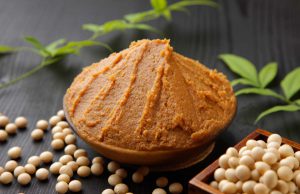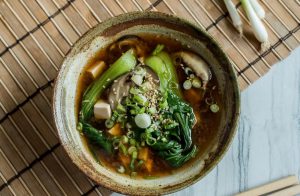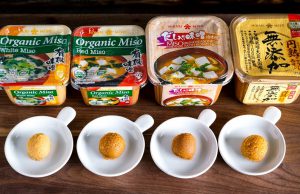Miso: the Probiotic Food that Fights Cancer and Lowers Cholesterol
Known in the Western world as the main ingredient used to make miso soup, time-honored miso paste has been used traditionally to help battle conditions like fatigue, stomach ulcers, high blood pressure and inflammation. Recent research shows that it may even be associated with other health benefits, including reduced cancer cell growth, enhanced digestive health and lower cholesterol levels. Plus, it’s considered one of the great probiotic foods, making it a worthy addition to any meal plan.

What is miso paste made out of? And what is miso good for? Keep reading for everything you need to know about this flavorful fermented ingredient.
What Is Miso?
Miso is a salty paste made from fermented beans (usually soybeans) that has been a staple ingredient in the Japanese diet for thousands of years. It can also be made using certain grains, such as fermented barley, rice or oats, mixed with salt and a bacteria called koji — which results in a range of miso tastes, colors and uses. It is one of the best condiments to keep on hand, as it’s versatile in recipes and packed with some noteworthy miso health benefits.
So where do you get miso? There are plenty of options for where to buy miso paste, and it’s typically available in the produce section of supermarkets, near other condiments, such as salad dressings. If you’re having trouble finding it at your local grocery store, you can also try searching in specialty Asian markets or health food stores.
Miso Products (Paste, Broth, Soup, Dressing, Etc.)
Miso is available in many different forms, each of which boasts its own unique flavor, aroma and uses.
Miso paste is among the most versatile products that is made from fermented soybeans. This flavor-packed ingredient is used as a seasoning to spice up nearly any dish, ranging from miso butter to miso ramen, miso rice and beyond.
Miso soup is another common variety, available in restaurants and supermarket shelves alike. So what is miso soup? It is a traditional Japanese dish which is made using a miso broth made from a softened paste. Along with the paste, other miso soup ingredients may include mushrooms, veggies, leafy greens and seaweed.
Miso sauce options, like miso dressing, are also available in certain stores, plus easy to make at home. For a simple miso salad dressing, simply mix white or yellow miso with rice vinegar and sesame oil, plus herbs and seasonings like ginger, cayenne pepper and garlic. Some recipes also call for other ingredients such as raw honey, soy sauce and olive oil. Not only can it dress up anything from salads to sushi, but it can also add a flavorful twist to side dishes.
Red vs. White Miso
Besides the many different miso products available, there are several varieties of miso available as well. Two of the most common types are red and white.
White miso paste is made from soybeans that have been fermented with a higher percentage of rice. This results in a lighter color and gives the final product a slightly sweeter taste.
Red miso, on the other hand, is made from soybeans that have been fermented for longer periods of time, typically with barley or other grains. It tends to have a deep, rich and salty flavor, plus a darker color that ranges from red to brown.
White miso works best in dressings, sauces and condiments due to its light flavor. Meanwhile, the intense flavor of red miso makes it well-suited for savory soups, glazes and marinades.
If you’re running out of red or white miso and looking for something to swap in, you may be wondering: What is a substitute for miso? Because of its rich flavor and stellar nutrient profile, there’s really no perfect miso paste substitute. In some cases, you may be able to use the white variety as a red miso substitute (and vice versa), but you should be prepared to switch up the amounts and seasonings in your recipe to help mask the differences in flavor.
Nutrition Facts
Check out the miso soup nutrition label and you’ll quickly understand exactly why this flavorful ingredient is so great for you. Each serving contains a low amount of calories, but a high amount of protein, fiber, manganese and vitamin K. It also contains a wealth of other important micronutrients, including copper, zinc, riboflavin and phosphorus.
One ounce (28 grams) of miso paste contains approximately:
• 56 calories
• 7.4 grams carbohydrates
• 3.3 grams protein
• 1.7 grams fat
• 1.5 grams dietary fiber
• 1,044 milligrams sodium (43% DV – recommended daily value)
• 0.2 milligrams manganese (12% DV)
• 8.2 micrograms vitamin K (10% DV)
• 0.1 milligrams copper (6% DV)
• 0.7 milligrams zinc (5% DV)
• 0.1 milligrams riboflavin (4% DV)
• 44.5 milligrams phosphorus (4% DV)
• 0.7 milligrams iron (4% DV)
In addition to the nutrients listed above, it also contains a small amount of magnesium, calcium, potassium, selenium and vitamin B6.
Health Benefits

1. Provides Beneficial Probiotics
Because miso is fermented and contains live active cultures, it’s a great source of probiotics, especially for those with lactose intolerance or a sensitivity to dairy products like kefir, yogurt and cultured cheeses.
The probiotics found in fermented foods boost the beneficial bacteria in the gut, increasing immunity and improving digestion. Probiotics are still being widely researched, but in recent years probiotics have been tied to health factors including:
• enhanced digestion
• improved immune function
• lower incidences of allergies
• better cognitive health
• lower risk for obesity
• mood regulation
• appetite control and much more
2. Improves Digestion
Eating miso in its most powerful, healing form — miso soup — is an easy way to improve digestion. The powerful probiotics found in it help combat digestive issues caused by an imbalance in gut bacteria, including constipation, diarrhea, gas, bloating and irritable bowel syndrome (IBS). Probiotics are even beneficial for people suffering from serious conditions like food allergies, ulcerative colitis and leaky gut syndrome.
If you’ve been overdoing it on commercial dairy products, baked sugary foods, processed grains and farm-raised animal products (eggs, cheese, milk), you can likely benefit from consuming plenty of probiotic-rich foods. Probiotics can help cleanse your system and ramp up your body’s ability to heal from gut-related illnesses.
3. May Reduce Blood Pressure
Although it is high in salt (sodium), it’s been linked to the prevention of high blood pressure according to both epidemiological and experimental evidence. For example, according to an animal model conducted at Hiroshima University, the sodium in miso might react differently than sodium chloride (NaCl) alone. These biological effects might be caused by longer fermentation periods of the soybeans, barley or rice grains above 180 days.
The study conducted at the Research Institute for Radiation Biology and Medicine found that systolic blood pressure in rats receiving 2.3 percent sodium chloride (NaCl) was significantly increased, but rats receiving the same amount of salt from miso did not experience these effects. The blood pressure of the rats consuming miso did not increase, even despite increasing their sodium intake.
Other similar animal models have found that long-term consumption of miso soup also halts blood pressure increases in mice with salt-induced hypertension or organ damage. It’s believed that this might be caused by a possible decrease of sodium absorption in the gastrointestinal tract, or by the direct effects of nutrients in the soup made from soybeans. The decrease in blood pressure levels despite higher sodium intake were associated with decreases in heart and kidney damage.
4. Fights Cancer Cell Growth
Thanks to its content of immune-enhancing probiotics, vitamins, minerals and antioxidants, it’s not surprising that miso has been linked to natural cancer prevention.
The Hiroshima University study also found that miso may be beneficial for preventing radiation injury and the progression of cancerous tumors. Researchers discovered that miso with a longer fermentation time (ideally 180 days) helped prevent tumor growth and increased healthy cell survival in mice following radiation.
Consuming fermented miso was also shown to block the growth of cancerous colon cells in mice and was linked to a lower risk of stomach tumors compared to a control group. Other animal models show that it is effective at scavenging free radicals and slowing the development of breast tumors.
Studies suggest that the prolonged fermentation process may be very important for protection against cancer and radiation. Miso at three different fermentation stages was tested in another study (early-, medium- and long-term fermented) and administered to mice for one week before irradiation. Interestingly enough, survival in the long-term fermented miso group was significantly longer than the short-term fermented miso group.

5. Good Source of Nutrients
Like other probiotic foods such as sauerkraut, kimchi and kombucha, miso helps to activate specific enzymes found in beans and grains that allow you to absorb the available nutrients that they provide. These include copper, manganese, B vitamins, vitamin K and phosphorus. Plus, it is also a decent source of plant-based protein, with over 3 grams per ounce.
6. Decreases Cholesterol Levels
High cholesterol can be detrimental when it comes to heart health; it causes plaque to build up in the arteries, blocking blood flow and increasing the risk of heart disease and stroke. Fortunately, promising human and animal studies show that miso could help reduce cholesterol levels to ward off heart disease.
For example, one study published in Japanese Pharmacology and Therapeutics showed that consuming miso soup for three months resulted in a 7.6 percent decrease in total cholesterol levels, plus significantly lower levels of bad LDL cholesterol compared to a placebo.
History
Miso has been consumed for generations in parts of Asia, and it’s still used on a daily basis in Japan as a flavor in miso soup and numerous solid foods. Considered an essential ingredient for Japanese cuisine, it supplies miso soup with its signature salty bite and healing properties.
Today more than ever, it is prized for its versatility in healthy cooking around the world. In the U.S., Europe and Australia, it is growing in popularity, especially in the health food scene where it’s commonly used in salad dressings, marinades, broths, soups and sauces.
As a “nitrogen fixer,” soybeans are said to be easy plants to grow since they help maintain the fertility of soil. An old practice in Japan is to grow soybeans around the edge of a rice paddy because the two plants are believed to make good companions for one another; together they keep away insects and pests well.
Miso is traditionally made by combining cooked soybeans or other legumes with the bacteria (or mold) called koji (Aspergillus oryzae). Soybeans are the traditional ingredient, but almost any legume can be used (barley, chickpeas, lentils and fava beans). Koji is typically grown on rice and is often available from Asian food markets in this form, if you ever want to try making your own homemade fermented miso and miso soup.
Miso comes in a wide variety of flavors because altering any step of the process — ingredients, ratio of ingredients, fermentation time — will affect the taste of the finished product. In Japan, differences in taste have become regional specialties, with some areas producing sweeter miso and some producing darker, saltier varieties.
Hacho miso is made using only soybeans, while natto miso is made using soybeans and benefit-rich ginger root together. Most other types are made using a combination of soybeans and grains.
How to Use
Treat yourself to some simple, homemade miso soup every day to easily take advantage of the many benefits that come along with consuming more probiotics and various nutrients. Or get creative and drop a tablespoon of it into your favorite homemade dressing, stock or sauces for some extra saltiness, tang and punch. You can also try using it to boost the flavor of your main course by making miso glazed veggies, or even adding it to a tasty ramen recipe.
Remember that although its sodium doesn’t seem to pose the same risks as the kind found in most packaged foods, it is a pretty salty food (one teaspoon has about 200-300 milligrams of sodium on average), and a little bit goes a long way. Sometimes just one teaspoon can add enough flavor to your meal, but using 2-3 teaspoons is fine when needed, too.
Just make sure you look for quality miso, the kind that’s organic (and made with fermented barley instead of soy, ideally – or non-GMO soy). It’s also important to buy refrigerated miso that has been fermented for at least 180 days (and even up to 2 years) and contains all of its live bacterial cultures.
If you come across powdered miso or soup that hasn’t been stored in the refrigerated section of your grocery store, it won’t contain the same beneficial probiotics. And if you don’t make sure to buy certified organic miso, there’s a good chance you’re getting a product made with GMO soybeans (check for the organic seal and words “certified organic” or “organic certified” on the label).

Interested in learning how to make miso soup at home? Simple! Just drop one tablespoon of miso into boiling water and add some scallions along with your favorite nutrient-dense sea vegetables (such as nori or dulse). You can make a flavorful and delicious vegan miso soup recipe using white miso along with fresh mushrooms, garlic, ginger, onions and collard greens. In order to enjoy the enzymes in miso, it is good to put in the paste at the end of cooking.
Risks and Side Effects
If you know you have a soy allergy, definitely stay away from miso. On the plus side, as with gluten products, fermentation likely changes some of the chemical structure of the soybeans and makes it easier to digest for most people since it becomes less inflammatory.
Soy also contains phytoestrogens, which mimic the effects of estrogen in the body. This could potentially impact the risk of conditions like breast cancer, cervical cancer, polycystic ovary syndrome (PCOS) and other hormone-related disorders, so more miso (or any soy product) is not necessarily better. While fermented soy poses less of a risk than processed soy and provides many other benefits, it’s still a good idea to consume in moderation.
As far as introducing probiotic foods goes, it’s best to ease into consuming these for most people. This allows your gut environment to slowly adapt and can help prevent diarrhea or other issues that a small number of people can face when first starting probiotics. Monitor how you feel and consider only having one to two sources of probiotics a day at first, at least until you become more used to their effects.
Finally, remember the sodium content of miso, especially if you have high blood pressure. While some research suggests that it may actually be beneficial for blood pressure levels, it’s still a good idea to moderate your intake to prevent adverse effects on health. Stick to 1-2 servings per day and be sure to pair with other healthy strategies to help naturally lower blood pressure levels.
Conclusion
• Miso is a paste made from fermented beans that is considered a staple in many traditional Japanese dishes.
• In terms of nutrition, each serving contains a low amount of calories along with plenty of protein, fiber, manganese and vitamin K.
• It’s available in both red and white varieties and can be found in several different products, including pastes, soups, broths and dressings.
• It is high in probiotics and may help reduce cholesterol levels and blood pressure, fight cancer cell growth and improve digestion.
• It’s also easy to use in a number of different recipes, from main dishes, marinades and glazes to soups, sauces and side dishes.
• To really maximize the potential health benefits, be sure to enjoy in moderation and increase intake slowly to prevent adverse effects on health.
yogaesoteric
March 6, 2023
Also available in:
 Français
Français
